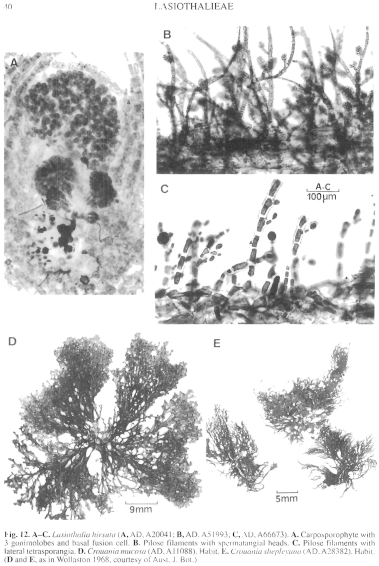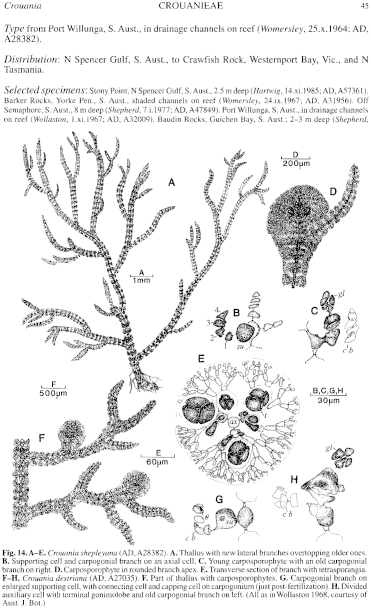|
|
|
|
|
|||||||||||
|
Electronic Flora of South Australia Species Fact Sheet
Phylum Rhodophyta – Order Ceramiales – Family Ceramiaceae – Tribe Crouanieae
Thallus (Figs 12E, 14A) mid to dark red-brown, 1–3 cm high, erect, slender and much branched irregularly, branches terete, flexuous and annular, branch apices pointed, axes ecorticate, not mucilaginous, with 3 whorl-branchlets (Fig. 14E) per axial cell. Base prostrate, attached by multicellular rhizoids; epilithic or epiphytic. Structure. Apices 3–10 cells long before initiation of whorl-branchlets, apical cells 10–14 µm in diameter and L/D 0.5–1, increasing to 80–120 (–180) µm in diameter and L/D 1–2 throughout lower axes; lateral branches arising from axial cells. Whorl-branchlets appearing banded on axes, 90–140 µm long (sometimes shorter below), branched 4–6 times, basal cells 10–15 µm in diameter and L/D 1–1.5, tapering to ovoid terminal cells 5–9 µm in diameter and L/D 1–1.5 (–2). Cells uninucleate; rhodoplasts discoid.
Reproduction: Gametophytes probably dioecious. Procarps (Fig. 14B) produced near apices of young branches, with a supporting cell bearing a 4-celled carpogonial branch. Post-fertilization the carpogonium connects to the auxiliary cell via a connecting cell and a narrow lower foot cell and upper gonimoblast cell are formed, the latter developing a terminal lobe (Fig. 14C) and later lateral lobes 250–400 µm across of ovoid carposporangia 30–50 µm in diameter, the carposporophyte being protected by surrounding whorl-branchlets (Fig. 14D). Spermatangia unknown.
Tetrasporangia (Fig. 14E) are borne on inner cells of whorl-branchlets, sessile, subspherical, (25–) 40–50 µm in diameter, tetrahedrally divided.
Type from Port Willunga, S. Aust., in drainage channels on reef (Womersley, 25.x.1964; AD, A28382).
Selected specimens: Stony Point, N Spencer Gulf, S. Aust., 2.5 m deep (Hartwig, 14.xi.1985; AD, A57361). Barker Rocks, Yorke Pen., S. Aust., shaded channels on reef (Womersley, 24.ix.1967; AD, A31956). Off Semaphore, S. Aust., 8 m deep (Shepherd, 7.i.1977; AD, A47849). Port Willunga, S. Aust., in drainage channels on reef (Wollaston, 1.xi.1967; AD, A32009). Baudin Rocks, Guichen Bay, S. Aust.; 2–3 m deep (Shepherd, 15.ii.1975; AD, A46128). Portland, Vic., on Rhodymenia, 7–9 m deep (Kraft 8265,27.iv.1990; MELU and AD, A66987). Sorrento, Vic., on Heterozostera, 5–6 m deep (Kraft 9010 & Drews, 8.vi.1992; MELU). Crawfish Rock, Westernport Bay, Vic., on Spyridia tasmanica, 0–1 m deep (Womersley, 16.i.1974; AD, A44768). Ulverstone, Tas., lower eulittoral pools (Wollaston, 21.ii.1964; AD, A27593).
Distribution: N Spencer Gulf, S. Aust., to Crawfish Rock, Westernport Bay, Vic., and N Tasmania.
Taxonomic notes: C. shepleyana is a small species, only 1–3cm high.
References:
WOLLASTON, E.M. (1968).Morphology and taxonomy of southern Australian genera of Crouanieae Schmitz (Ceramiaceae, Rhodophyta). Aust. J. Bot. 16, 217–417.
The Marine Benthic Flora of Southern Australia Part IIIC complete list of references.
Publication:
Womersley, H.B.S. (24 December, 1998)
The Marine Benthic Flora of Southern Australia
Rhodophyta. Part IIIC. Ceramiales – Ceramiaceae, Dasyaceae
©State Herbarium of South Australia, Government of South Australia
Illustrations in Womersley Part IIIA, 1998: FIGS 12E, 14 A–E.

Figure 12 enlarge
Fig. 12. A–C. Lasiothalia hirsuta (A, AD, A20041; B, AD, A51993; C, AD, A66673). A. Carposporophyte with 3 gonimolobes and basal fusion cell. B. Pilose filaments with spermatangial heads. C. Pilose filaments with lateral tetrasporangia. D. Crouania mucosa (AD, A 11088). Habit. E. Crouania shepleyana (AD, A28382). Habit. (D and E, as in Wollaston 1968, courtesy of Aust. J. Bot.)

Figure 14 enlarge
Fig. 14. A–E. Crouania shepleyana (AD, A28382). A. Thallus with new lateral branches overtopping older ones. B. Supporting cell and carpogonial branch on an axial cell. C. Young carposporophyte with an old carpogonial branch on right. D. Carposporophyte in rounded branch apex. E. Transverse section of branch with tetrasporangia. F–H. Crouania destriana (AD, A27035). F. Part of thallus with carposporophytes. G. Carpogonial branch on enlarged supporting cell, with connecting cell and capping cell on carpogonium (just post-fertilization). H. Divided auxiliary cell with terminal gonimolobe and old carpogonial branch on left. (All as in Wollaston 1968, courtesy of Aust. J. Bot.)

|
Email Contact: State Herbarium of South Australia |

|